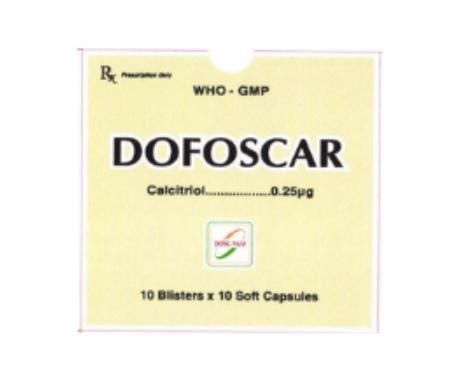This is an automatically translated article.
Calibin drug has the ability to maintain calcium levels in the blood, enhance calcium absorption to reduce the risk of fractures due to pathological osteoporosis. Therefore, the drug is indicated for use in people at risk of osteoporosis and some other related diseases.
1. What is Calibin?
Calibin medicine contains the active ingredient Calcitriol, one of the active metabolites of vitamin D3. Normally, this substance will be formed in the kidneys from its precursor, 25 - hydroxycholecalciferol (25 - HCC). In adults, 25 - HCC is formed per day 0.5 - 1.0 mg and increased more during periods of high bone formation (such as children in the growth phase or pregnant women). Calcitriol helps to create a favorable environment for intestinal calcium absorption and regulates bone mineralization, and stimulates bone formation for the treatment of osteoporosis.
In patients with severe renal impairment, endogenous calcitriol synthesis tends to decrease or may be completely stopped. In this case, calcitriol deficiency was considered to be the main cause of renal osteodystrophy.
In patients with renal-induced osteoporosis, the use of Calibin will contribute to the normalization of impaired calcium absorption in the intestine, making an important contribution to the correction of hypocalcaemia. Calibin will be effective in reducing bone and muscle pain, correcting histological aberrations in fibromyalgia and some other disorders of mineralization.
For people with postoperative hypoparathyroidism, spontaneous hypoparathyroidism or pseudohypoparathyroidism, using Calibin will reduce hypocalcemia as well as improve clinical symptoms Optimal.
In patients with vitamin D-responsive rickets, serum calcitriol concentrations are often low or absent. At this time, when endogenous calcitriol in the kidney is not sufficient, the use of Calibin is often considered as an alternative therapy.
For patients with rickets unresponsive to vitamin D (rickets caused by primary hypophosphatemia), the use of Calibin will contribute to minimizing phosphate excretion through the renal tubules, helping to normalize the formation of calcium. bone wall due to the addition of phosphorus sources.
In addition, Calibin is also quite effective when used to treat other forms of rickets such as rickets associated with hepatitis in infants, biliary underdevelopment, people with cystine dystrophy or the delivery of cysts. There is a deficiency in calcium and vitamin D through daily meals.
2. Indications and contraindications to using Calibin
2.1. Indications to use Calibin With the above effects, Calibin is often indicated for use in the following cases:
Patients with renal osteoporosis or chronic renal dialysis causes. People with hypocalcemia, hypocalcemia in idiopathic hypoparathyroidism, postoperative hypoparathyroidism and pseudohyperparathyroidism. 2.2. Contraindications to use Calibin Do not use Calibin for people with hypersensitivity to drug components, hypercalcemia or a history of vitamin D toxicity.
3. Dosage and how to use Calibin
Common patients: Using the drug with a starting dose of 0.25 mcg/day, when dialysis is used at a dose of 0.5 mcg/day, patients > 6 years of age with hypoparathyroidism respond to a dose of 0.5 - 2 mcg/ day, children under 6 years old use from 0.25 - 0.75 mcg / day. Postmenopausal osteoporosis patients: Use starting dose 0.25mcg x 2 times/day. Note that it should be closely combined with the daily diet to promptly increase the dose to 0.25mcg if the amount of calcium provided from the meal is less than 500mg/day. Renal osteodystrophy in patients with chronic renal failure: Calibin is used at an initial dose of 0.25 mcg/24 hours and 0.25 mcg/48 hours in subjects with normal or mildly hypocalcaemia. After 2-4 weeks of drug therapy, if the disease does not show signs of deterioration, the dose can be increased by 0.25 mcg/24 hours, and closely monitored blood calcium levels with a frequency of 2 times / week. . Hypoparathyroidism and rickets: Use Calibin with a starting dose of 0.25mcg/day, taken in the morning. If the disease has not progressed after 2-4 weeks of treatment, the user can increase the dose by 0.25 mcg/day while closely monitoring serum calcium levels at least 2 times/week.
4. Side effects
Taking Calibin may cause some common side effects such as fatigue, headache, nausea, dry mouth, increased BUN/liver enzymes, loss of appetite, itching.5. Drug interactions
Taking Calibin with preparations containing vitamin D and other drugs containing calcium may increase blood calcium . Concomitant use with Cholestyramine affects the intestinal absorption of calcium. Calibin interacts with Phenobarbital, phenytoin affects endogenous calcium synthesis, causing a decrease in serum calcium concentration. Concomitant use with Digitalis will increase blood calcium can cause arrhythmia. Co-administration of thiazide diuretics increases the risk of hypercalcemia in patients with hypoparathyroidism. Avoid using with corticosteroids, calcium channel blockers, antacids that will inhibit calcium absorption.
6. Be careful when using Calibin
Use the drug starting with the lowest dose, should not be increased suddenly and the dose must be adjusted gradually to ensure balance according to the serum calcium concentration. During the use of Calibin, patients should be closely monitored for blood calcium levels (at least twice a week) to avoid sudden hypercalcemia due to dietary changes. People with normal kidney function need to drink plenty of water when taking Calibin to avoid possible dehydration. Caution should be exercised when prescribing for pregnant and lactating women, people with a history of kidney stones or coronary artery disease. The basic information about Calibin in the above article is for reference only. Because this is a prescription drug, patients should not use it on their own, but need to contact a specialist directly to get an appropriate prescription to ensure safety for health.













